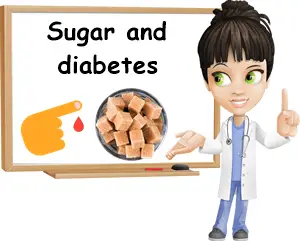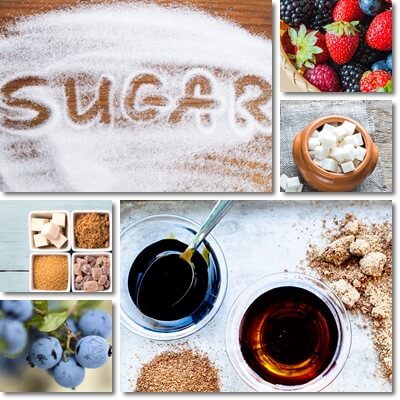The same thing that happens to non-diabetics: the sugar is digested and quickly absorbed into the bloodstream, raising blood glucose (sugar) levels or the concentration of sugar in the blood. Then the pancreas secretes the hormone insulin to help move the sugar out of the blood and into muscle cells, liver cells, basically wherever it’s needed. The trouble is that either liver, muscle and other cells that normally take up the sugar don’t respond properly to the hormone insulin (happens in type 2 diabetes) or insulin is simply produced in insufficient amounts (happens in type 1 diabetes). This causes the sugar eaten and absorbed to stay in the blood for too long.
Now, if this is a rare occurrence (it may occur when we fill up on carbs and sweets), it isn’t that much of a problem. But in the context of an insufficient insulin production by the pancreas or a defective response of cells to insulin (insulin resistance), both characteristics of diabetes mellitus, excess sugar in the blood happens all the time. And this is a problem because, over time, it can lead to tissue and organ damage. This is actually where all the problems associated with diabetes originate and the reason why diabetic patients are advised to limit their intake of digestible carbohydrates (simple sugars included) per day and per meal and given insulin.

By limiting how much digestible carbs you eat in a day and per meal, you basically give your body lower amounts of sugar to process at a time and don’t overwhelm it. This helps because it gives the body a fighting chance when it comes to moving it out from the blood to where it’s needed (especially considering there may be an insufficient insulin production or defective response to it).
Now, all sugar, whether table sugar or sugar from fruits, is the same thing when it comes to molecular composition. But this doesn’t mean that, as a diabetic, you can have either one.
Eating one or the other makes a huge difference for diabetes since one is absorbed quickly into the bloodstream, all at once, raising blood glucose levels too high too fast, while the other is absorbed more steadily, contributing to a more balanced blood glucose metabolism.
Let’s take two examples: table sugar vs whole fruit – also a source of sugar. The difference between table sugar and fruit sugar for diabetes is:
Table sugar (or sucrose) is made up of glucose and fructose, two simple forms also found in most fruits. If you were to eat it, you’d get just that: table sugar. Whereas the sugar in fruits and other plant foods, also usually glucose and fructose, is not alone: it’s packed in a solid mass of skin, pulp and water containing all sorts of elements, from digestible carbohydrates (complex and simple) to indigestible carbohydrates (fiber, cellulose), fat, protein, vitamins, minerals, antioxidants. And some of these other elements influence how the simple sugar forms in the fruit or other plant food are absorbed.

What happens when a diabetic gets sugar from a fruit (vegetable, nut, seed or cereal) is fiber, fats and protein all affect its absorption into the bloodstream. Fiber is basically indigestible plant material, meaning it does not contribute to our nutrition, doesn’t get absorbed into the bloodstream. But fiber slows down digestion of food and emptying of the stomach as well as absorption of nutrients at the intestinal level. This means it also slows down the absorption of sugar, contributing to a steadier rise in blood glucose levels and preventing fluctuations.
Fats and protein, which are generously found in nuts and seeds, take longer to be digested and automatically slow down all of digestion, including that of sugar. The benefit of this is, once again, steadier blood glucose levels, which a major goal for diabetics.
The other nutrients in whole foods that influence sugar absorption are proof that plant food is a safer choice for a diabetic than refined table sugar.
With diabetes, certain foods and food categories are definitely preferred to others. But, in the end, to get optimal nutrition, a diabetic must get all of their essential nutrients. This includes macro-nutrients (carbohydrates, fat and protein) and micro-nutrients (vitamins and minerals). All of these are essential for sustaining life and good health. So, as a diabetic, you kind of need to eat both animal foods and plant foods to be healthy. It’s just that you may need to eat less of some types of food, particularly fruits and vegetables high in carbohydrates.
This is because digestible carbohydrates (that actively contribute to your nutrition, that are digestible) are ultimately broken down into their simplest forms, simple sugars. And what does sugar from food do? You got it: it’s absorbed into the bloodstream and contributes to blood glucose levels. But it helps if that happens slower or at a steadier rate.
Another reason why a diabetic benefits more from eating a fruit or a vegetable than refined sugar is whole plant foods contain what is known as complex carbohydrates. These are the types of carbs take longer to be digested (they are complex and need to be broken down into simpler elements, which takes time). As a result, they fill you up and curb hunger, which also helps with weight loss. They can be found in vegetables and unrefined grains in particular, but also fruits. Now, these complex carbs are also broken down into their simplest components following digestion, which are simple sugars. But the reason they are better for diabetics is because they slow down digestion and the rate at which sugar is absorbed into the bloodstream, preventing unhealthy fluctuations.
Conclusion
So what happens when a diabetic patient eats sugar is dependent on intake and source of the sugar. Table sugar is downright unhealthy and should be avoided, whether plain or added to various foods. Products like honey or fruit syrups or molasses are best avoided too because they are essentially concentrated forms of simple sugars.
But sugar coming from unprocessed, whole foods such as fruits or vegetables is acceptable and well tolerated by most diabetics, in limited amounts, because other components of the whole foods (example: fiber) ensure a steadier absorption into the bloodstream and prevent unhealthy fluctuations. Also, some of the sugar in certain foods is put together in such a way that it requires time to be broken down and this also contributes to better blood glucose management in diabetes.
If diabetics eat refined sugar or processed foods containing lots of it (either too much at once or small amounts frequently), what happens is there will be a continual state of high blood glucose levels (hyperglycemia) which will cause tissue damage and organ damage over time. This includes damage to the optical nerve, nervous system, kidneys, skin and cardiovascular system, among others.
But most diabetics can eat a variety of fruit, vegetables and other plant foods safely with their condition as long as they keep intake low enough so they don’t exceed their recommended daily intakes of carbohydrates, a crucial aspect of successfully managing the metabolic condition. Some may eat more of some fruits, others less, depending on the severity of their condition, especially degree of insulin resistance and current health status (weight is an important aspect), but usually moderate, limited amounts are advised.
